
 China Tours
China Tours Tibet Tours
Tibet Tours China Theme Tours
China Theme Tours Off The Beaten Track
Off The Beaten Track Yangtze Cruises
Yangtze Cruises China Trip Planner
China Trip Planner Travel Agents
Travel Agents


We had a wonderful time in Tibet. We have learned a lot about this unique destination because of the wonderful guide Degyi who is so knowledge and always available towards our tours. We stayed at the Shangri-La Hotel Lhasa, and we would never imagine a Tibet travel could be so nice and amazing without the help of Degyi.
Also, thanks a lot to our Tibetan driver Mr.Wongdun for his safe driving and a good sense of service along the way.
We shall return Tibet in the near future!
P.B. and A. A - Europe
Tibet Travel
June 2018 (Private Tibet Journey from Kathmandu)

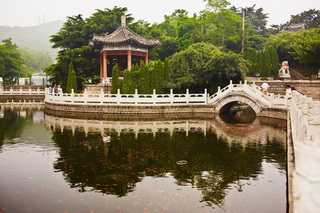 Suzhou, a city to the south of the lower reaches of the Yangtze River, enjoys a worldwide reputation for its delicate and classical gardens. Most of the gardens were built for private use by aristocrats and rich businessmen and date back to the sixth Century BC. Garden design went through an active period during the Ming Dynasty (1368-1644). By the time of the latter years of the Qing Dynasty (1644-1911), a large number of classical gardens were spread across Suzhou as well as its suburbs. Ten of these gardens are still in a good state of preservation, including the Humble Administrator's Garden (Zhuozheng Garden), the Lingering Garden (Liu Garden), the Garden of the Master of the Nets (Wangshi Garden), the Villa with Embracing Beauty (Huanxiu Mountain Villa), the Blue Wave Pavilion (Canglang Pavilion), the Lion Grove Garden (Shizilin), the Garden of Pleasance (Yi Garden), the Couple's Garden Retreat (Ou Garden) and others. The first four of these exhibit a typical character of classical gardens such as structure, style, cultural attainment, aesthetics and arrangement of the furniture. For this reason they have been included in UNESCO's World Heritage List since the end of 1997.
Suzhou, a city to the south of the lower reaches of the Yangtze River, enjoys a worldwide reputation for its delicate and classical gardens. Most of the gardens were built for private use by aristocrats and rich businessmen and date back to the sixth Century BC. Garden design went through an active period during the Ming Dynasty (1368-1644). By the time of the latter years of the Qing Dynasty (1644-1911), a large number of classical gardens were spread across Suzhou as well as its suburbs. Ten of these gardens are still in a good state of preservation, including the Humble Administrator's Garden (Zhuozheng Garden), the Lingering Garden (Liu Garden), the Garden of the Master of the Nets (Wangshi Garden), the Villa with Embracing Beauty (Huanxiu Mountain Villa), the Blue Wave Pavilion (Canglang Pavilion), the Lion Grove Garden (Shizilin), the Garden of Pleasance (Yi Garden), the Couple's Garden Retreat (Ou Garden) and others. The first four of these exhibit a typical character of classical gardens such as structure, style, cultural attainment, aesthetics and arrangement of the furniture. For this reason they have been included in UNESCO's World Heritage List since the end of 1997. In general, the gardens are comprised of two parts - a residential section and a garden. In order to replicate a natural environment on a miniature scale but to be full of life, pavilions, ponds, bridges, rockeries, stones and fragrant flowers are added to the gardens. The artistic layout is combined perfectly with Chinese philosophy and ideology to exhibit an architectural culture of the Orient. In a small plot each component is designed delicately and arranged orderly by the accomplished gardeners to show their creativity. Lyric pictures and poems are reflected in the themes of the gardens to evoke mountains and natural springs requiring the visitor only to observe the seasonal change of plants and water. Strolling in the garden, visitors experience an elegant cultural aura which has almost disappeared from modern life. Steles and parallel couplets of halls or names of rooms sometimes show the masters' aspirations, interests, and ideals or followings of Buddhist, Taoist and Confucian thoughts or philosophy. 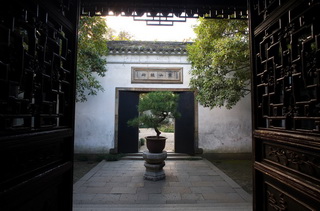
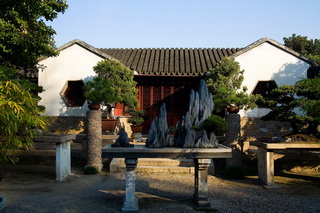
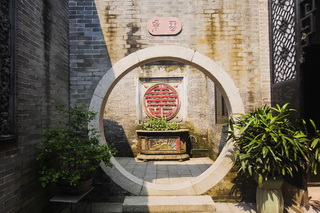
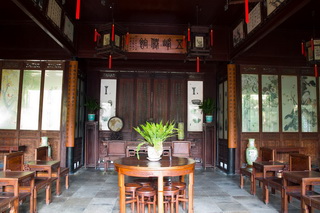
Using unique skills combining architecture with the surrounding scenery, artisans created gardens that are tranquil havens away from the world's turmoil. Very often tourists think they have reached the last building of a garden, only to discover another harmonious landscape when they pass through the room and along a zigzag corridor.
Each door and window of the rooms is decorated with carvings. Looking through the incised window of a garden, a lush green waterscape unfolds itself before your eyes while a babbling stream mirrors singing birds on a stone bridge. When a pavement winds along mountain ridges, visitors will see a different view. In the living rooms, the rosewood furniture is simple but very elegant. Valuable works of calligraphy and paintings are displayed.
Residential rooms are usually decorated with Suzhou-styled bonsais and parallel couplets. The classical gardens, as assemblies of residences and gardens, demonstrate the living habits and etiquette of ancient Chinese peoples of the lower reaches of the Yangtze River.
China Trip Planner | Travel Agents | About Us | Why Us | Contact Us | How to Pay | How to Book - Terms & Conditions | Site Map
Copyright © 2010 - 2030 All Rights Reserved.


 0086-28-85711328
0086-28-85711328 0086-28-85546015
0086-28-85546015




